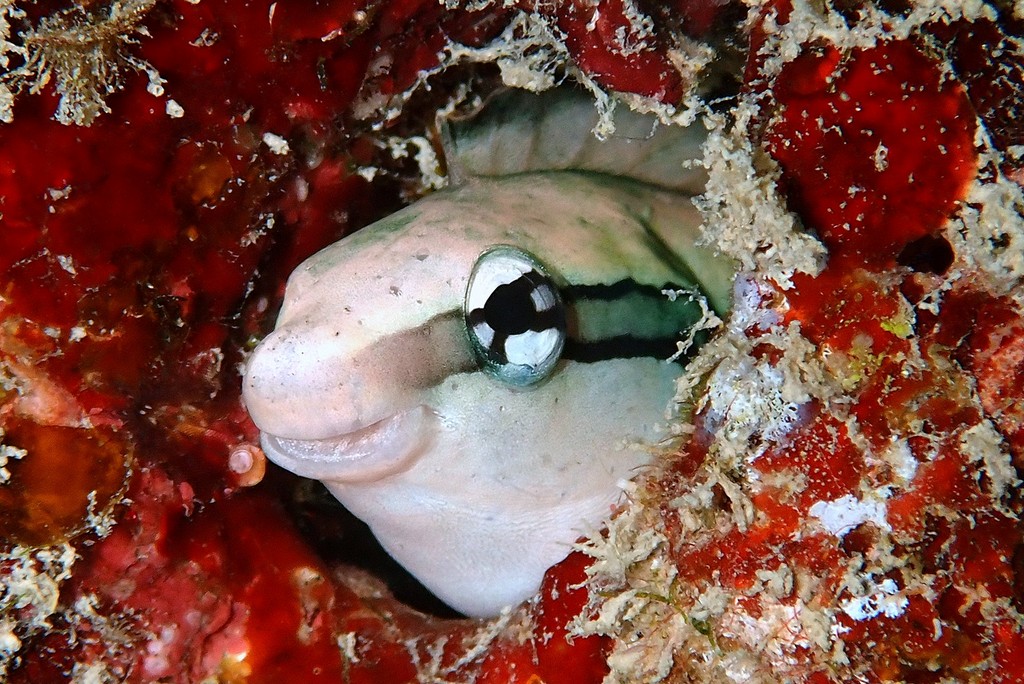ASPIDONTUS TAENIATUS - (QUOY & GAIMARD, 1834)
Picture courtesy of: Alain Daoulas
Faux nettoyeur, Cleaner mimic, False cleanerfish, False cleaner, False cleaner fish, Mimic blenny, Falscher putzerfisch, Nise-kurosujiginpo, ニセクロスジギンポ, 三带盾齿鳚, 三帶盾齒鳚,
Synonymes
Aspidontus taeniatus taeniatus (Quoy & Gaimard, 1834)
Blennechis filamentosus (Valenciennes, 1836)
Petrocirtes taeniatus (Quoy & Gaimard, 1834)
Petroscirtes azureus (Jordan & Seale, 1906)
Petroscirtes rostratus (Valenciennes, 1836)
Petroskirtes paradiseus (Bleeker, 1854)
------------------------------
Distribution
Dorsal spines (total): 10-12; Dorsal soft rays (total): 26-28; Anal spines: 2; Anal soft rays: 25-28; Pectoral fin rays: 13-15; Pelvic fin rays: I, 3; Ventral fin rays: 40-44; Segmented caudal rays: 11; Body depth: 5.0-6.5 in SL. Body moderately elongate. Mouth inferior, opening on ventral side, the conical snout srongly overhanging; Teeth in jaws small and slender except for a very large recurved canine on lower jaw anteriroly. Gill opening small, gill membranes on both sides separated. Anterior end of dorsal fin elongate in juveniles. Four small cirri in a transverse row on chin; Origin of dorsal fin posteriror to rear of eye, nearly uniform in height (except for prejuveniles where it is elevated anteriorly); Caudal fin truncate to slightly rounded. Max. length: 11.5 cm TL. Depth range: 1 - 25 m.
Color
Variable, longitudinal black stripe on body increasing in width posteriorly, reaching (near) posterior end of caudal fin usually.
Etymology
Aspidontus: from Latin, aspis = snake, aspic, viper + from Greek, odontos = teeth. In reference of the very large recurved canine on each side of the lower jaw and a small canine on each side at back of upper jaw like a snake.
taeniatus: from Latin, taenia, taenio = ribbon or band. Referring to two pale stripes alternating with two dark stripes on sides of body.
Original description: Aspidontus taeniatus Quoy & Gaimard, 1834 - Type locality: Agana, Guam, Mariana Islands, western Pacific; Northern New Guinea.
Distribution
Red Sea; Indo-West Pacific: KwaZulu-Natal (South Africa), East Africa, Socotra (Yemen), Seychelles, Aldabra (Seychelles), Comoros, Madagascar, Saint Brandon's Shoals (Cargados Carajos) and Mascarenes (La Réunion, Mauritius, Rodrigues), east to Marshall Islands, Marquesas Islands and Tuamotu Archipelago (French Polynesia), north to Kagoshima Prefecture (southern Japan) and Ogasawara Islands (Japan), south to southern New South Wales (Australia) and New Caledonia.
Biology
Adults are found solitary or in small groups in lagoons, subtidal reef flats and outer reef slopes. Often in pairs in empty worm tubes or narrow holes. They mimic the cleaner wrasse Labroides dimidiatus and nip fins, skin and scales of other fishes. They even copy the motion of the cleaner wrasse that may induce other fish to come close, then target their scales or mucus for a feed, biting and quickly retreating to the corals before the victim realizes that it was tricked; Experienced fish recognize imposters and often give it a chase. Diet is supplemented with benthic invertebrates and zooplankton. Also feed on tubeworms and demersal fish eggs. Oviparous. Eggs are demersal and adhesive, and are attached to the substrate via a filamentous, adhesive pad or pedestal. Larvae are planktonic, often found in shallow, coastal waters.
Similar species
Aspidontus dussumieri (Valenciennes, 1836) - Reported from New Caledonia - Link to the species (here).
Aspidontus tractus (Fowler, 1903) - Reported from Red Sea, Western Indian Ocean: East Africa, South Africa, Socotra, Aldabra, Comoros, Madagascar, Saint Brandon's Shoals and Mascarenes (if valid).
Labroides bicolor (Fowler & Bean, 1928) - Reported from New Caledonia - Link to the species (here).
Labroides dimidiatus (Valenciennes, 1839) - Reported from New Caledonia - Link to the species (here).
Plagiotremus goslinei (Strasburg, 1956) - Reported from Hawaiian Islands (endemic).
Plagiotremus rhinorhynchos (Bleeker, 1852) - Reported from New Caledonia - Link to the species (here).
Plagiotremus tapeinosoma (Bleeker, 1857) - Reported from New Caledonia - Link to the species (here).
Last update: 24, August 2024
